The United States is hopefully, fingers crossed, entering a solar module manufacturing renaissance. After having its domestic supply decimated by China’s precise buildout of solar manufacturing over the last decade, manufacturing tax credits included in the Inflation Reduction Act should provide a lifeline to the market. As it stands today, U.S. solar panel manufacturing consists only of module assembly in the crystalline silicon space, but the promised credits could rebuild the domestic chain and bring silicon ingot, wafer and cell manufacturing back home.
The hard work begins now. With various steps in module manufacturing taking years to build out from scratch, industry folks should be wary of new-name companies promising ribbon cuttings within the next year. If all goes well, the United States should begin hitting its domestic manufacturing stride by 2025.
Until then, Solar Power World has gathered information on the companies already making modules in the United States and provides a summary here of their expansion plans related to the new IRA credits. Only new outlets that have earned our editorial team’s utmost confidence are included in this list. Companies that previously announced plans to establish U.S. manufacturing (Ubiquity Solar in New York and NanoPV in Georgia, for example) were unable to give Solar Power World official statements on timelines, so we were not comfortable with including them here.
Want to see a map and a chart of this information?
Check out our U.S. panel manufacturing page here.
Auxin Solar
California OPERATING
Auxin Solar, the small-scale solar panel OEM in San Jose, California, that is publicly at the center of the ongoing AD/CVD circumvention investigation, is still invested in manufacturing in the United States. The company has a stated annual manufacturing capacity of 150 MW, and reps told Solar Power World that the actual capacity is “well beyond that,” but no official numbers were provided. Auxin was actively planning expansions and placed orders for new equipment before decisions around IRA tax credits were announced. While the IRA is a step in the right direction, Auxin CEO Mamun Rashid said that the United States can “never out-subsidize China,” and fair trade policy is critical to domestic solar manufacturing success.
Convalt Energy
New York OPENING 2023
The company that bought the equipment previously used at the SolarWorld factory in Oregon has moved everything to New York and expects to have a 900-MW panel assembly plant open by mid-2023. The vintage equipment still makes use of smaller wafer sizes. Convalt Energy is also looking into an ingot, wafer and solar cell manufacturing factory if enough capital can be raised. Convalt CEO Hari Achuthan told Solar Power World that starting production on domestic ingots and wafers may be “aspirational,” but it’s the route the U.S. market is moving toward. The manufacturing tax credits only validate Convalt’s manufacturing roadmap that was established more than two years ago.
Crossroads Solar
Indiana EXPANDING
South Bend, Indiana-based solar panel assembler Crossroads Solar started in 2021, amidst supply chain woes and uncertain policy progress. Crossroads reached 12 MW of annual manufacturing capacity in 2022, using a labor force comprised of men and women who traditionally struggle to find good employment. All of Crossroads’ employees are felons reintegrating into society. President Patrick Regan said that with the assistance of IRA credits, his small-scale operation — which he expects to bring to 40 MW of annual capacity with the opening of an additional line — could be adopted in more communities needing local employment.
First Solar
Ohio EXPANDING / Southeast OPENING 2025
First Solar has three thin-film solar panel factories sited near each other in Northwest Ohio that will have a cumulative capacity of 7.1 GW in 2023 after the third factory is completed. The third factory was announced pre-IRA passage, but First Solar’s total Ohio manufacturing capacity was increased by 900 MW after manufacturing tax credits were included in the bill.
Federal support of solar manufacturing did lead to First Solar announcing it would invest up to $1.2 billion in a fourth thin-film solar panel manufacturing facility somewhere in the Southeast. The new facility will have an annual capacity of 3.5 GW and should open by the end of 2025.
GAF Energy
California OPERATING / Texas OPENING 2023
Roofing + solar company GAF Energy is betting big on its nail-able solar shingle product, breaking ground on a second manufacturing facility in August 2022. The company supports 50 MW of solar shingle production in its original San Jose, California, factory, and is building a new facility in Georgetown, Texas, that should produce 250 MW annually when it reaches full operation by the end of 2023. The manufacturing expansion was announced before IRA credits were secured.
Heliene
Minnesota EXPANDING / Florida OPERATING
Heliene is close to opening its second solar panel manufacturing facility in Iron Mountain, Minnesota. This 420-MW facility is next door to its original 150-MW factory, which president Martin Pochtaruk said Heliene will increase to 300 MW by April 2023. These two upgrades were committed to before IRA passed.
With tax credits announced, Pochtaruk told Solar Power World that Heliene wants to open another module line and eventually a solar cell manufacturing facility to stop depending on imports. No official decisions will be made until the administration of the manufacturing tax credits are better established.
Heliene also operates a 100-MW panel factory in Riviera Beach, Florida.
JinkoSolar
Florida OPERATING
Chinese megacompany JinkoSolar opened a 400-MW panel assembly plant in Jacksonville, Florida, in late 2018. The manufacturer largely works through distributors in the United States and has previously had supply agreements with NextEra and Florida Power & Light.
Jinko did not provide Solar Power World with an official statement on its future manufacturing plans in the United States.
Meyer Burger
Arizona OPENING 2023
Swiss solar technology company Meyer Burger first announced plans to start solar module assembly in the United States in September 2021. The company chose Goodyear, Arizona, for a 400-MW capacity facility due to its proximity to customers and scheduled production to start by the end of 2022. But when manufacturing tax credits weren’t included in early infrastructure bills, Meyer Burger put its U.S. plans on hold.
After the IRA passed, Meyer Burger announced it would restart construction on the U.S. factory and make it even bigger — the company now plans on reaching 1.5 GW of panel manufacturing capacity as soon as possible. Production at the site will be split: 1 GW of utility-scale panels and 500 MW of solar panels for the DG sector will be made in Arizona.
Mission Solar
Texas OPERATING
Small-scale panel assembler Mission Solar has been opening its San Antonio factory for more installer tours lately, but its 200-MW manufacturing capacity is likely stalled for now until it can update its lines to the larger wafer sizes coming to dominate the market. When asked at the RE+ show how large the factory can become, Mission’s VP of marketing Paul Mutchler said that is dependent on the quality of supply its upstream vendors can provide. Mission did not provide Solar Power World with an official statement on its future manufacturing plans in the United States.
Oct. 24 update: Mission Solar plans to expand its Texas factory to 1 GW by 2024.
Qcells
Georgia EXPANDING
The country’s largest crystalline silicon solar panel assembler, Qcells will expand its Dalton, Georgia, manufacturing capacity to 3.1 GW by Summer 2023. Already operating a 1.7-GW plant, the company owned by Hanwha Group is building a 1.4-GW factory next door. Qcells committed to this second factory before the IRA passed, so more Hanwha investments to the supply chain are coming with the guaranteed credits.
Hanwha invested in polysilicon maker REC Silicon, and plans are underway for ingot, wafer and cell production to set up somewhere in the United States. It was reported by local news that Hanwha is shopping sites in Texas, Georgia and South Carolina for a potential 9-GW integrated plant. Scott Moskowitz, senior director and head of market intelligence, public affairs and marketing for Qcells North America, told Solar Power World that the company is working on its plans.
“There’s lots of incentive for folks to move quickly, given that the credits start on Jan. 1 and begin to phase down in the latter part of the 10 years,” he said.
Silfab
Washington EXPANDING
Canadian panel assembler Silfab operates twin 400-MW manufacturing facilities in Washington, and executive advisor Geoff Atkins told Solar Power World that the company ordered equipment and was proceeding with plans to add two new production lines at one of the plants prior to the IRA passing. The manufacturing tax credits in IRA have “accelerated Silfab’s plans for greater expansion in the United States,” but nothing has officially been confirmed.
Besides expanding its 800-MW annual module assembly capacity in the United States, Silfab is developing a new module design using proprietary back-contact cells that would require in-house manufacturing. Silfab solar cell manufacturing may be setting up in the United States, but the company told Solar Power World it was not yet ready to announce firm plans.
Solar4America
California EXPANDING
The former Sunergy solar panel factory in Sacramento was restarted under a new name in January 2022: Solar4America. The brand name is owned by parent company SPI Energy, which has had no shortage of ambitious plans to announce throughout 2022. In addition to solar panels, the company is the distributor of the all-electric EdisonFuture pickup truck and plans to bring 1.5 GW of wafer manufacturing stateside through an outfit called SEM Wafertech. The wafer plans were announced just a few weeks after the IRA was passed. The group of SPI Energy companies were unable to confirm details to Solar Power World.
Regarding the solar module assembly plant, Solar4America fluctuates in the stated capacity of the factory. Believed to be operating today at 650-MW annual capacity, the company has also stated it could reach either 1.1 or 2.3 GW by early 2023. Datasheets show modules using a range of wafer sizes, from old-school M2s used in traditional 60- and 72-cell modules, on up to the two largest in the industry: M10 and G12. If lines are already equipped to handle the largest wafer sizes, gigawatt-scale expansions could be possible in 2023 by Solar4America.
SunSpark
California OPERATING
SunSpark, a small-scale OEM in Southern California, has been operating a 250-MW facility in Riverside since 2015. A portion of that plant’s output had been distributed through a co-branding deal with local installer SolarMax Technologies. Company reps at the RE+ show told Solar Power World that the company has opened a second factory in nearby City of Industry, California, that is making two new updated modules, also revealed at RE+. No other details could be confirmed by press time.
SunTegra
New York OPERATING
SunTegra caters to an exclusive group with its solar shingle product made in Binghamton, New York. The company told Solar Power World in the past that it completes about 50 roofs each year, mostly in upper-middle-class neighborhoods in the Northeast. SunTegra’s annual production capacity is around 10 MW and is unlikely to grow much larger due to its unique application.
Toledo Solar
Ohio EXPANDING
The only other CdTe thin-film solar panel maker in the United States, Toledo Solar caters to the residential and small commercial markets at its 100-MW annual manufacturing capacity plant near First Solar’s HQ in Perrysburg, Ohio. CEO Aaron Bates told Solar Power World that the credits included in IRA give more confidence to the finance world that solar manufacturing is a bankable investment. Steps are in motion to increase Toledo Solar’s capacity to 300 MW, with plans to reach 2.8 GW by 2027.
“We already committed the capital, and that will increase [with IRA credits],” Bates said. “It allows us to further lower the cost of manufacturing, which is critical for a level playing field. These are not small numbers. For us, you’re talking $40 million per leap of growth, from 100 to 300 MW, 300 to 600 MW, etc. For First Solar, they’re doing billion-dollar projects. These are not small endeavors.”
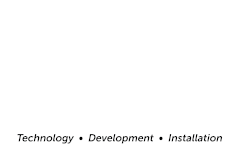
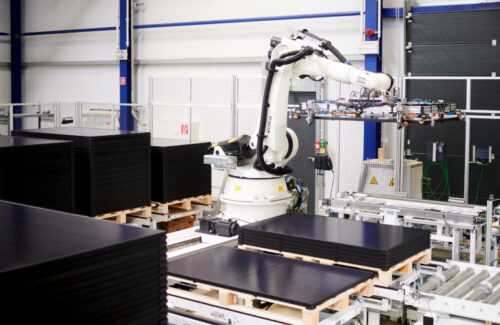
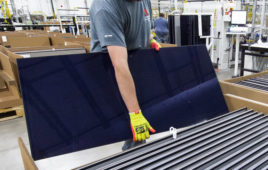
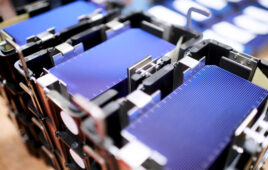
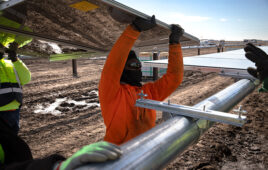
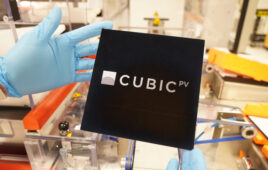
Is there a reason SEG is not included. Thanks for the great article!
What about ADT, formerly known as Sun Pro? Supposedly they are manufactured in Alabama.
ADT likely whitelabels other solar panel brands. There are no panels made in Alabama today.
Great article Kelly! The landscape is changing quickly, hopefully you can provide updates over time. Thank you!
Kelly, thank you for this article! Quick questions, does Silfab and Qcell actually manufacture their panels in Washington and Georgia or just assemble? I need a panel for a client that is actually “Made In the USA”
Thanks
All companies just assemble in the United States. There are no silicon wafer or cell production in the United States
Kelly, what about First Solar with their thin film?
Thin-film is different than silicon. First Solar does everything within the United States.
Are there any lightweight/flexible PV manufacturers left in the USA?
I only included companies making full-sized solar panels for traditional rooftop or ground-mount installs. There are some smaller companies doing flexible designs for mobile applications, but I did not confirm with them.
Hello Kelly, is there any CPV (concentrator photovoltaic) manufacturing in the US?
None that I am aware of, I really only focus on solar PV.
Lumos Solar — made in USA.
I didn’t include panels that are made at OEM factories, but yes, Lumos does make its specialty modules in the United States
Thank you, Kelly,
Super informative this is great information.
Great update. Thanks.
Kelly, I’ll follow You everywhere ! Keep up the great reporting !
You’ll be my $unshine ( tm )
Comparing the “attitude” of companies like Meyer Berger to established companies like First Solar one can see the fear of failure looming over Meyer Burger. First Solar started out 22 years ago without a Federal energy subsidy or a comprehensive IRA loan and financing program.
“But when manufacturing tax credits weren’t included in early infrastructure bills, Meyer Burger put its U.S. plans on hold.” Waiting for a government gravytrain energy bill is NOT a sign of commitment, Meyer Burger may be just another “also ran” in solar PV manufacturing.
Toledo Solar seems to be years behind using old First Solar footprint of 121Watt panels that were around in the First Solar Series 2 or 3 panels back in the early 2000s. For a lot of roofs, using more panels could well represent a RSD module nightmare to meet fire safety compliance and shutdown. When safety devices can cost more than the solar PV panels, one has to think about panel choice when designing their system.
What about the Sunpower panels??? and the new Tesla panels???
Not made in the United States.
Global RAIS in 2023.
Following!
Tesla solar panels are made in Buffalo, New York.
Nothing is being made in Buffalo at this moment. Tesla uses third-party full-sized solar panels and its solar shingle product for the solar roof is currently being made in China.
Do you have a source that shows no solar being made in New York?
Great work Kelly! It’s so difficult to separate the marketing from reality so I appreciate the amount of work that went into this article.
I’m sure the industry would love to see identical articles on batteries, inverters, and transformers.
Keep up the good work
Sad legacy from SolarCity/Tesla Solar…
https://www.wgrz.com/article/money/business/what-happened-to-the-50m-in-tesla-equipment-stored-in-wheatfield/71-13fbbc1f-c8b5-437b-a10a-9331113675a9
I heard someone tried to buy the equipment but Tesla said no. Oof.